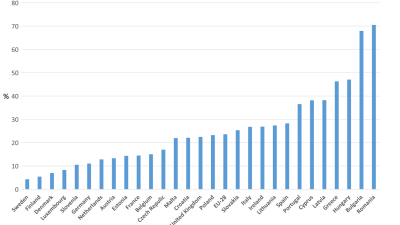This table shows the percentage of the survey sample in Great Britain in 1983, 1990, 1999 and 2012 describing the item or activity as necessary. It covers items and activities asked about in 2012 which were also asked in one or more of the previous surveys.
The table is ranked by the percentage thinking the item is necessary in 2012. You can rank by the other survey years by clicking on that year.You can rank by other years by clicking on that year. Colour gradients have been applied to each item in each year so where 100% think an item is ‘necessary’ it is shaded deep red moving through orange to yellow where around 50% think the item is necessary and then moving to green as the percentages further decline so it is the deepest green when 0% think the item is a necessity. So looking at the table as a whole, the more uniform the shading across all years, the less change there has been across all years. Trends stand out because different years are coloured differently (more red if a higher proportion in a particular year think the item a necessity and more yellow and then more green if a lower proportion do). In the left hand column adult items and activities are shaded dark grey and child ones light grey.
You can also choose to look at items and activities that just apply to adults and those that just apply to children. And you can filter by category which includes items and activities and also a range of other types such as food, clothing and social (some items and activities are in more than one of these catgeories).
Download data in csv format
Overview
The surveys show a sharp rise in support for a number of consumer items over the last thirty years – such as a washing machines, phones and cars. Over this period the relative prices of such household and consumer items has dropped sharply and their ownership has become much more widespread. The rise in support could reflect a general rise in expectations as living standards rise but could also reflect the fact that once a good becomes widespread alternatives.
Since 1983 one item has moved to become a necessity - the telephone – with support rising from 43% in 1983 through 56% in 1990 and to 77% in 2012. This could reflect the lack of alternatives once an item becomes established – in 1983 there was still a public telephone box on many streets but no longer as well as the relative drop in price.
On the other hand, some items and activities have fallen in popularity. This is in part because taste and customs have changed. The role of the ‘roast joint’ is a good example – once an important family meal on a Sunday it has become a less and less popular and the percentages seeing this as a necessity has sunk from 57% in 1983 to a mere 36% today (in 1990 “or vegetarian equivalent” was added to the question to reflect the rise in vegetarianism).
The latest survey suggests that overall people are less generous than in 1999. In the more constrained economic conditions of 2012, the public seem to have adjusted their views of what constitutes a minimum living standard. Apart from consumer goods, the overall pattern across most of the items and activities for which there is mid-levels of support is a decline in the proportions seeing the item as a necessity. Indeed, a number of former necessities have moved to being ‘non-necessities’.
For a commentary on this table see Facts and Findings 3: What do we think we need?We will be publishing detailed working papers anaysing these findings shortly.
Survey details
The ‘Necessities of Life’ survey was carried out between May and June 2012 and is based on a sample of 1,447 adults aged 16 or over in the Britain and 1,015 in Northern Ireland. The survey was carried out by the National Centre for Social Research (NatCen) in Britain and by the Northern Ireland Statistics and Research Agency (NISRA) in Northern Ireland as part of their Omnibus surveys.



 PSE:UK is a major collaboration between the University of Bristol, Heriot-Watt University, The Open University, Queen's University Belfast, University of Glasgow and the University of York working with the National Centre for Social Research and the Northern Ireland Statistics and Research Agency. ESRC Grant RES-060-25-0052.
PSE:UK is a major collaboration between the University of Bristol, Heriot-Watt University, The Open University, Queen's University Belfast, University of Glasgow and the University of York working with the National Centre for Social Research and the Northern Ireland Statistics and Research Agency. ESRC Grant RES-060-25-0052.






